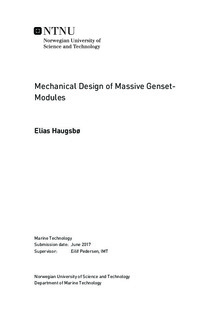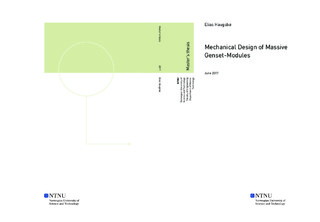| dc.description.abstract | The research conducted in this thesis aims to develop a mechanical design of a large electric propulsion system. This electric propulsion system consisting of multiple genset operating together to reduce operation cost and emissions. The idea with this configuration is to design a stacking frame with room for 12 genset in the power range 200 to 400 kW. By adjusting the number of frames and generators, power output from this configuration can meet a large variety of vessel types and deliver a flexible solution.
The massive genset system is intended to consist of three main parts, a stacking frame that allow compact storage of the modules, the genset-module designed as a canopy and connection system for exhaust and auxiliary systems. Since the diesel engine produce dynamic loads from operation it is important to investigate if the frame can withstand the vibration excitation from multiple gensets. To analyze the load acting on the frame it is required to make a dynamic model of the engine mounting system, that give the excitation force from the reciprocating motion. The method used to develop the model is based on the Lagrange equation of motion with implementation into Bond graph. This allow simulation of a rigid body system that evaluate frequency response and excitation force in the mountings.
The frame module was modulated in SolidWorks where the dynamic loads was implemented into a multi-body simulation tool. The result is compared to DNV GL rules for machinery vibration in steel structures. The results show that the frame design is within the limitations from vibration excitations of machinery. How the genset can be connected together with a common supply system is discussed, a few possible configurations are introduced and visualized through sketches. Finally, a sketch of the machinery room layout presented. The work conducted in this thesis is not a complete design of the massive genset system, but can give a good foundation for further development of the concept. | |

